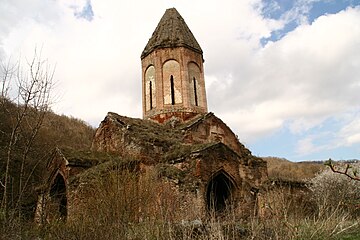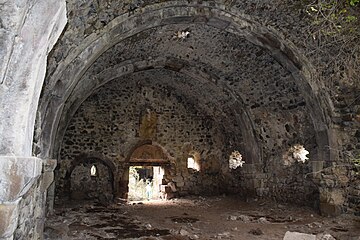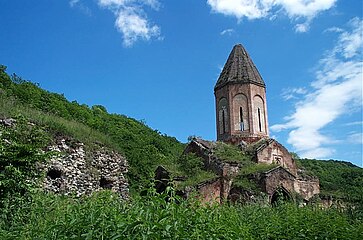Kirants Monastery
Kirants Monastery is an 13th-century Armenian monastery located about 10 kilometers southwest of Kirants village in the Tavush Province of Armenia.[1] The Georgian Orthodox Church in Armenia has laid claim to the monastery, which the Armenia Apostolic Church rejects.[2]
The Kirants Monastery was probably founded by the Zakarid ruler Avag Zakarian, who was a of Chalcedonian faith like his father.[3] The frescoes of the monastery can be dated to the 1230s-1240s.[3]
The story behind Kirants is extraordinary. This church, unlike most monasteries built in Armenia, is constructed mostly of brick and mortar. "Kir" is the word for mortar. "-ants" brings meaning that the previous word has "passed" the level, or is not level or uneven. The village had one very rich man who had one very beautiful daughter. A master craftsman and mason had fallen in love with the daughter and she with him. However, he came from a very poor family and he knew that he would have a difficult time convincing her father to allow him to have her hand in marriage. He tried nonetheless and the rich man said he would give his blessing if he the craftsmen well known for his talents would build him a church in the village. The craftsman agreed and built the beautiful church. He was on the top of the "drum or dome" and near completion of the church when the rich man came to see how things were coming along. The Craftsman asked the rich man "how does the church look?" the rich man responded by saying it looks great but "kiren antsa" or the line of the brick and mortar looks uneven. From this statement the craftsman, who was so excited that the church would be finished and he could marry his love, realized that the rich man had no intention to grant his daughters hand in marriage and jumps from the "drum or dome" taking his own life.
This story is how "Kirantsi vank" or the "Kirants Monastery" got its name.
Gallery
- Kirants Monastery
-

-

- Drum and dome
-

-

-
 Detail of the mosaics tiles on around the drum
Detail of the mosaics tiles on around the drum -

- Interior of the church
- Interior of the drum and dome
References
- ^ Karanian, Matthew; Kurkjian, Robert (2006). The Stone Garden Guide: Armenia & Karabagh. Stone Garden Productions. pp. 186–187. ISBN 978-0-9672120-9-8.
- ^ Król-Mazur, Renata (2016). "The role of the Georgian Apostolic Autocephalous Orthodox Church in conflicts in the South Caucasus". Studia z Dziejów Rosji i Europy Środkowo-Wschodniej. 51 (2): 117–152. doi:10.12775/SDR.2016.EN2.05. ISSN 1230-5057.
- ^ a b Lidov, Aleksej M. (1991). The mural paintings of Akhtala. pp. 14–16. doi:10.11588/diglit.27365.
The Kirants Monastery is not mentioned in any historical sources, however, indirect evidence suggests that it was founded by the Chalcedonian Avag, the son and heir of Ivane Mkhargrdzeli. The wall paintings there can thus be dated to the 1230s or 1240s.
External links

- Armeniapedia.org: Kirants Monastery
- v
- t
- e
- Aragatsotn
- Arshakid Mausoleum
- Aruchavank
- Astvatsankal
- Byurakan
- Garnahovit
- Hovhannavank
- Karbi
- Karmravor
- Kasagh
- Kosh
- Kristapori Vank
- Mastara
- Oshakan (St. Mesrop, Tukh Manuk)
- Saghmosavank
- Mughni
- Talin
- Tegher
- Ushi
- Vahramashen
- Voskevaz
- Yeghipatrush
- Zarinja
- Targmanchats Vank
- Vagharshapat (Etchmiadzin, St. Gayane, St. Hripsime, St. Mary, Shoghakat)
- Zvartnots
- Ddmashen
- Hayravank
- Kotavank
- Makenyats Vank
- Noratus (Cemetery, St. George)
- Sevanavank
- Tsovinar
- Vanevan
- Yot Verk
- Geghard
- Gharghavank
- Havuts Tar
- Kecharis
- Makravank
- Mashtots Hayrapet
- Mayravank
- Neghutsi Vank
- Ptghavank
- Tejharuyk
- Yeghvard (St. Mary)
- Monastery
- Bardzrakash
- Haghpat
- Hnevank
- Horomayri
- Khuchap
- Kobayr
- Odzun
- Sanahin
- Sverdlov
- Vanadzor (St. Mary)
- Goshavank
- Haghartsin
- Jukhtak Vank
- Kirants (Arakelots)
- Makaravank
- Matosavank
- Samsonavank
- Tsrviz
- Voskepar
- Avan (Tsiranavor)
- Kanaker (St. James)
- Yerevan (Gethsemane, Katoghike, St. Gregory, St. John, St. Paul and Peter, Zoravor)




- Agulis (St. Thomas)
- Amaras
- Aprakunis
- Baku (St. Gregory, St. Mary, St. Thaddeus)
- Dadivank
- Gag
- Gandzasar
- Gtichavank
- Hakobavank
- Jugha (Holy Savour)
- Katarovank
- Kish
- Kusanats Anapat
- Shusha (Ghazanchetsots, Kanach Zham)
- Targmanchats
- Tsar
- Tsitsernavank
- Vankasar
- Yeghishe Arakyal
- Yerits Mankants
- Tbilisi (Vank, Bethlehem, Chugureti, Ejmiatsnetsots, St. George, St. Gregory, Jigrasheni Avetyats, Kamoyants, Karapet, Karapi, Karmir Avetaran, Geghardavank, Mughni, Norashen, Holy Sign, St. Sarkis, St. Stephen, Zrkinyants)
- Tskhinvali
- Adana (St. Mary)
- Agarak
- Aghperig
- Aghtamar
- Akner
- Bagnayr
- Akori
- Ani (Cathedral, Tigran Honents, Kizkale, Holy Apostles)
- Aparank
- Arakelots Vank
- Arapgir
- Arkakaghni
- Arter
- Bana
- Barthoghimevos Vank
- Constantinople (Galata, Kuzguncuk, Fatih, Kartal, Samatya, Taksim, Beyoğlu, Beyoğlu)
- Drazark
- Elazig
- Eskişehir
- Gaziantep
- Goms
- Hogots
- Horomos
- Ishkhan
- Kanzak
- Karapet Vank
- Karmravank
- Kars (Cathedral, St. Mary)
- Kes
- Khtzkonk
- Ktuts
- Marinos Vank
- Mren
- Mush (St. Marine, Holy Sign)
- Narekavank
- Por
- Sivrihisar
- Skanchelagordz Vank
- Smyrna
- Soradir
- Tekor
- Tigranakert
- Trebizond
- Varagavank
- Varzahan
- Yeghegnamor
- Yeghrdut
- Yerazgavors
- Thadei Vank
- Maghardavank
- Dzordzori Vank
- Hovi
- Darashamb
- Haftvan
- Khoy
- Mahlezan
- Tabriz (St. Mary, St. Sarkis, Mariam)
- Mujumbar
- Sohrol
- Sarnaq
- Nor Jugha (Vank, St. Mary, St. George, St. Stephen, St. John, St. Catherine, Bethlehem, St. Nicholas, St. Gregory, St. Sarkis, Isfahan, St. Minas, St. Nerses)
- Tehran (St. Thaddeus, St. George)
- Armenian Quarter
- Cathedral of St. James
- Church of St. Toros
- Church of the Holy Archangels
- Monastery of St. Saviour
- Chapel of St. Helena
- Lviv (St. Mary)
- Nor Nakhichevan (Holy Cross)
- Sultan-Saly
- St. Petersburg (St. Catherine)
  | This article about an Armenian Christian monastery, abbey, priory or other religious house is a stub. You can help Wikipedia by expanding it. |
- v
- t
- e
 | This article on an Oriental Orthodox place of worship in Armenia is a stub. You can help Wikipedia by expanding it. |
- v
- t
- e





















